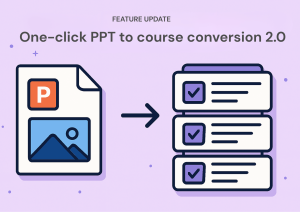
Create a Course That Sells: Top Tips and Best Practices
- Author: Urban Rotar
- Published:

How do I validate my online course idea?
Research your target audience’s needs using surveys and tools like Google Trends. Analyze competitors’ offerings to identify gaps and opportunities for differentiation.
What platform should I use to host my online course?
Choose a platform that is user-friendly, offers necessary features like video hosting and quizzes, and aligns with your budget and technical expertise.
How can I engage with students in my online course?
Build an online community using platforms like Facebook Groups or Discord. Regularly interact with students, encourage feedback, and offer support to maintain engagement.
Key Takeaways - Create a Course That Sells:
- Validate Your Course Idea: Research your target audience and competitors to ensure demand and differentiate your course in a competitive market.
- Choose the Right Platform: Select a user-friendly course platform that fits your needs, considering features, pricing, and scalability.
- Engage with Your Audience: Build a community around your course to foster loyalty and retention through ongoing interaction and feedback.
- Create a Sales Strategy: Use pre-selling, a strong sales page, and effective marketing to maximize your course’s reach and revenue.
- Start Building Your Online Course Business Today: Implement these tips and best practices to create a successful online course that resonates and sells.
Creating a course that resonates and sells requires more than just subject matter expertise. Whether you’re a seasoned professional or exploring online courses for the first time, this guide will help you transform your knowledge into a profitable and engaging course by following the multi-step process of online course creation. From understanding why creating an online course can be beneficial to practical steps for developing course material, we’ll walk you through every stage. Let’s dive in!
Why Create an Online Course?
Identify the Opportunity to Share Your Knowledge and Expertise with a Wider Audience
Creating a course allows you to share your insights and skills with people beyond your immediate reach. The digital age offers a unique platform for sharing expertise, making it accessible to anyone with an internet connection. Creating online courses is crucial for addressing specific needs within underserved audiences, allowing course creators to leverage their expertise to fill gaps in the market.
Benefits of Creating an Online Course Include Increased Credibility, Passive Income, and Scalability
Online courses can elevate your status as an authority in your field. They also offer the potential for passive income, as once the course is created, it can generate revenue with minimal ongoing effort. Plus, the scalability of online courses means you can teach hundreds or even thousands of students without the limitations of a physical classroom.
Validate Your Course Idea by Researching Your Target Audience and Competition
Before you start creating, ensure there’s a demand for your course. Research your audience’s needs and look at your competitors. This step helps you refine your idea and develop a course that truly meets a need.
Create a Unique and Valuable Online Course that Solves a Problem or Meets a Need
The key to a successful online course is its value proposition. What problem does your course solve? How does it meet the needs of your audience? Answering these questions will help you create a course that stands out. When considering how to create a course, start by selecting the best online course creation platform. Consider factors such as budget, time, and audience before launching. Begin with a course marketplace for beginners and validate your course content before moving to a dedicated course website.

Identify the Opportunity
Research Popular Topics and Trends in Your Industry
Start by exploring what’s trending in your field. Use tools like Google Trends, social media platforms, and industry forums to see what topics are generating buzz. This can give you insight into what potential students are interested in learning.
Identify Gaps in the Market and Areas for Improvement
Look at existing courses and identify what’s missing. Are there common questions that aren’t being answered? Are there advanced topics that aren’t covered? Filling these gaps can make your course more appealing.
Use Online Tools and Resources to Validate Your Online Course Idea
Online tools like SurveyMonkey or Google Forms can help you gather feedback on your online course idea. Create a survey to understand what potential students are looking for and adjust your course content accordingly. Validating your course concept ensures it addresses a market need and stands out in a competitive landscape.
Benefits of Creating an Online Course
Increase Your Credibility and Authority in Your Industry
Publishing a course can significantly boost your credibility. When people see you as a course creator, they perceive you as an expert, which can open doors to more opportunities. When you create online courses, it’s crucial to select a marketable topic and understand your target audience to ensure success.
Generate Passive Income and Scalability
One of the biggest advantages of online courses is their potential for passive income. Once created, a course can be sold repeatedly without additional work. This means your earning potential isn’t tied to the number of hours you work.
Share Your Knowledge and Expertise with a Wider Audience
Online courses remove geographical barriers, allowing you to reach a global audience. This not only expands your reach but also diversifies your student base.
Create a Community Around Your Course and Engage with Your Students
Building a community around your course fosters engagement and loyalty. Platforms like Facebook Groups or Discord can be great for creating a space where students can interact, ask questions, and share their progress.

Validate Your Course Idea
Research Your Target Audience and Their Needs
Understanding your audience is crucial. Use tools like Facebook Audience Insights or Google Analytics to gather data about your potential students. This will help you tailor your course content to their specific needs and preferences.
Analyze Your Competition and Identify Areas for Differentiation
Look at your competitors’ courses. What are their strengths and weaknesses? Identifying these can help you create a course that offers something unique.
Use Online Tools and Resources to Validate Your Course Idea
Tools like Typeform or SurveyMonkey can help you get feedback on your course idea. Ask potential students about their learning needs, preferences, and what they’re willing to pay for.
Choosing the Right Topic
Pick a Profitable Online Course Topic that Aligns with Your Expertise and Passion
Your course topic should be something you’re both knowledgeable and passionate about. This will make the course creation process more enjoyable and your content more engaging.
Consider Your Target Audience and Their Needs
Think about who you’re creating the course for. What are their pain points? What skills do they want to learn? Tailoring your course to meet their needs will increase its appeal.
Research Popular Topics and Trends in Your Industry
Stay updated on industry trends. Follow blogs, join forums, and participate in social media groups related to your field to see what topics are currently popular.

Pick a Profitable Online Course Topic
Choose a Topic that is in Demand and Has a Large Audience
Select a topic that people are actively searching for. Use tools like Google Keyword Planner or Ubersuggest to find high-demand topics with a substantial audience.
Consider the Competition and Identify Areas for Differentiation
Look at what’s already available and think about how your course can offer something different. This could be a unique teaching style, additional resources, or a different perspective.
Use Online Tools and Resources to Research Popular Topics and Trends
Leverage online tools to validate your course topic. Tools like BuzzSumo can show you what content is performing well in your industry.
Your Passion and Expertise
Choose a Topic that You Are Passionate About and Have Expertise In
Your enthusiasm for the subject will come through in your teaching, making the course more engaging for students. Additionally, your expertise will ensure that the content is valuable and credible.
Consider Your Strengths and Weaknesses
Be honest about your strengths and areas for improvement. This will help you create a course that plays to your strengths and addresses any potential weaknesses.
Use Your Passion and Expertise to Create a Unique and Valuable Online Course
When you’re passionate and knowledgeable about a topic, you’re more likely to create content that resonates with your audience.
Your Target Audience
Identify Your Target Audience and Their Needs
Knowing who your audience is and what they need is crucial. Use surveys, forums, and social media to gather insights about your target market.
Research Their Pain Points and Challenges
Understanding your audience’s challenges will help you create a course that addresses their specific needs and provides real value.
Create a Course that Meets the Needs of Your Target Audience
Tailor your course content to solve your audience’s problems and meet their needs. This will make your course more appealing and effective.
Understanding Your Audience
Research Your Target Market and Their Needs
Deep dive into your target market. Use tools like Google Analytics, Facebook Audience Insights, and online surveys to gather detailed information about your potential students.
Analyze Your Competitors and Identify Areas for Differentiation
Look at the courses your competitors offer. Identify what they’re doing well and where they fall short. Use this information to create a course that offers something unique.
Identify Your Unique Selling Proposition
What sets your course apart from others? Whether it’s a unique teaching style, additional resources, or a different perspective, make sure to highlight what makes your course special.
Research Your Target Market
Use Online Tools and Resources to Research Your Target Market
Leverage tools like SEMrush, Google Trends, and social media analytics to gather data about your target market. This will help you understand their interests and needs better.
Identify Their Pain Points and Challenges
Engage with your potential students through surveys, forums, and social media. Understanding their pain points will help you create a course that addresses their specific challenges.
Create a Course that Meets the Needs of Your Target Market
Develop course content that provides solutions to your audience’s problems. This will increase the value of your course and its appeal to potential students.

Analyze Your Competitors
Research Your Competitors and Their Strengths and Weaknesses
Look at the top courses in your niche. Identify what they do well and where they could improve. Use this information to make your course better.
Identify Areas for Differentiation
Find gaps in your competitors’ offerings that you can fill. This could be in the form of additional resources, a different teaching approach, or more comprehensive coverage of the topic.
Use Your Unique Selling Proposition to Stand Out from the Competition
Highlight what makes your course unique. Whether it’s your teaching style, the depth of content, or additional resources, make sure your USP is clear.
Identify Your Unique Selling Proposition
Identify What Sets Your Course Apart from the Competition
Determine what makes your course different. This could be your teaching approach, the comprehensiveness of the content, or additional resources you provide.
Use Your Unique Selling Proposition to Market and Promote Your Course
Your USP should be a key part of your marketing strategy. Highlight it in your course descriptions, promotional materials, and marketing campaigns.
Create a Course that is Unique and Valuable
Your course should offer something that others don’t. This could be in-depth content, a unique teaching style, or additional resources.
Creating Compelling Learning Outcomes
Write Effective Learning Objectives that Align with Your Course Content
Clearly define what students will learn from your course. Use specific, measurable objectives to guide your course creation.
Identify What Students Will Learn from Your Course
Make sure your course content is aligned with your learning objectives. This will help ensure that your course delivers on its promises.
Create a Course that is Engaging and Interactive
Use a variety of teaching methods to keep students engaged. This could include videos, quizzes, and interactive exercises.
Write Effective Learning Objectives
Use Clear and Concise Language
Your learning objectives should be easy to understand. Use straightforward language to clearly communicate what students will achieve.
Identify Specific Skills and Knowledge that Students Will Gain
Be specific about what students will learn. This will help them understand the value of
your course and what they can expect to achieve.
Use Learning Objectives to Guide Your Course Content
Your learning objectives should inform the structure and content of your course. This will help ensure that your course is focused and effective.
What Will Students Learn from Your Course?
Identify the Skills and Knowledge that Students Will Gain
Clearly outline what students will learn from your course. This will help them understand the value of your course and what they can expect to achieve.
Create a Course that is Comprehensive and Covers All the Necessary Material
Make sure your course content is thorough and covers all the necessary material. This will help ensure that your course delivers on its promises.
Use Learning Objectives to Guide Your Course Content
Your learning objectives should inform the structure and content of your course. This will help ensure that your course is focused and effective.
Structuring Your Online Course
Plan Your Course with an Instructional Design Storyboard
Use a storyboard to plan your course curriculum. This will help you visualize the content and ensure that it flows logically.
Create a Logical Course Outline that is Easy to Follow
Organize your course content into a clear, logical outline. This will make it easier for students to follow and understand.
Use a Course Platform to Host and Deliver Your Course
Choose a reliable course platform to host and deliver your course. This will help ensure that your course is accessible and user-friendly.
Plan Your Course with an Instructional Design Storyboard
Use a Storyboard to Visualize Your Course Content
A storyboard can help you plan the structure and flow of your course. This will make it easier to organize your content and ensure that it’s cohesive.
Identify the Key Elements of Your Course
Determine the main topics and subtopics that your course will cover. This will help you create a comprehensive and focused course.
Use a Storyboard to Guide Your Course Creation
A storyboard can serve as a roadmap for creating your course content. This will help ensure that your course is well-organized and effective.
Create a Logical Course Outline
Use a Course Outline to Organize Your Course Content
An outline can help you organize your content and ensure that it’s logically structured. This will make it easier for students to follow and understand.
Identify the Key Elements of Your Course
Determine the main topics and subtopics that your course will cover. This will help you create a comprehensive and focused course.
Use a Course Outline to Guide Your Course Creation
An outline can serve as a roadmap for creating your course content. This will help ensure that your course is well-organized and effective.

Producing Your Online Course
Use Best Practices for Filming and Recording
High-quality production can enhance the learning experience. Use good equipment, and record in a quiet environment to ensure clear audio and video.
Edit and Post-Produce Your Course Content
Editing is crucial for creating a polished final product. Use editing software to cut out mistakes, add graphics, and improve the overall quality.
Use a Course Platform to Host and Deliver Your Course
Choose a platform that’s easy to use and provides a good experience for your students. Consider features like video hosting, quizzes, and student interaction tools.
Best Practices for Filming and Recording
Use High-Quality Equipment
Good equipment can make a big difference in the quality of your course videos. Invest in a good camera, microphone, and lighting.
Record in a Quiet and Distraction-Free Environment
Choose a quiet location for recording to ensure clear audio. Minimize background noise and distractions.
Use a Script and Storyboard to Guide Your Filming and Recording
A script can help you stay on track and ensure that you cover all the necessary material. A storyboard can help you plan the visuals.
Tips for Editing and Post-Production
Use Video Editing Software to Edit and Post-Produce Your Course Content
Editing software can help you create a polished final product. Use it to cut out mistakes, add graphics, and improve the overall quality of your videos.
Add Captions and Subtitles to Your Videos
Captions and subtitles can make your course more accessible to a wider audience. They can also help with comprehension.
Use Music and Sound Effects to Enhance Your Course Content
Music and sound effects can make your course more engaging. Use them sparingly to enhance the learning experience.
Selecting the Right Platform
Choose the Best Online Course Platform for Your Needs
Research different platforms to find one that meets your needs. Consider features, pricing, and user experience.
Consider Self-Hosting vs. Online Course Marketplaces
Each option has its pros and cons. Self-hosting gives you more control, but requires more technical knowledge. Marketplaces can provide more exposure, but may take a cut of your profits.
Use a Platform that is User-Friendly and Easy to Navigate
Choose a platform that’s easy for both you and your students to use. A good user experience can make a big difference in the success of your course.
Choose the Best Online Course Platform for Your Needs
Research and Compare Different Platforms
Look at different platforms and compare their features, pricing, and user experience. This will help you choose the best one for your needs.
Consider the Features and Pricing of Each Platform
Make sure the platform you choose has the features you need at a price you can afford. Consider things like video hosting, quizzes, and student interaction tools.
Use a Platform that is User-Friendly and Easy to Navigate
Choose a platform that’s easy for both you and your students to use. A good user experience can make a big difference in the success of your course.
Self-Hosting vs. Online Course Marketplaces
Consider the Pros and Cons of Self-Hosting vs. Online Course Marketplaces
Self-hosting gives you more control over your course, but requires more technical knowledge. Marketplaces can provide more exposure, but may take a cut of your profits.
Use a Platform that is User-Friendly and Easy to Navigate
Choose a platform that’s easy for both you and your students to use. A good user experience can make a big difference in the success of your course.
Consider the Features and Pricing of Each Platform
Make sure the platform you choose has the features you need at a price you can afford. Consider things like video hosting, quizzes, and student interaction tools.
Pricing and Sales Strategy
Establish a Pricing Structure for Selling Online Courses
Research different pricing structures and choose one that’s fair and competitive. Consider the value of your course and the competition.
Create a Sales Page that Converts
A good sales page can make a big difference in your course’s success. Make sure it’s clear, concise, and visually appealing.
Use Marketing and Promotion to Sell Your Course
Effective marketing is key to selling your course. Use a variety of strategies, including email marketing, social media, and paid advertising.

Establish a Pricing Structure for Selling Online Courses
Research and Compare Different Pricing Structures
Look at what other courses in your niche are charging and choose a pricing structure that’s competitive. Consider the value of your course and what students are willing to pay.
Consider the Value of Your Course and the Competition
Make sure your pricing reflects the value of your course. Take into account the competition and what they’re offering.
Use a Pricing Structure that is Fair and Competitive
Choose a pricing structure that’s fair and competitive. This will help attract students and maximize your revenue.
Create a Sales Page That Converts
Use a Sales Page that is Clear and Concise
A good sales page is key to converting visitors into students. Make sure it’s clear, concise, and easy to navigate.
Identify the Key Elements of Your Course
Highlight the main benefits and features of your course. This will help potential students understand what they’ll get out of it.
Use a Sales Page that is Visually Appealing and Easy to Navigate
A visually appealing sales page can help attract and retain visitors. Make sure it’s easy to navigate and highlights the key elements of your course.
Launching and Marketing Your Course
Pre-Sell Your Course for Maximum Impact
Pre-selling can help build anticipation and validate your course idea. Offer a discount or incentive for early buyers to generate interest and initial sales.
Use Webinars and Lead Magnets to Grow Your Email List
Webinars and lead magnets are effective ways to attract potential buyers and grow your email list. Offer a free resource or incentive for signing up.
Use Marketing and Promotion to Sell Your Course
Effective marketing is key to selling your course. Use a variety of strategies, including email marketing, social media, and paid advertising.
Pre-Sell Your Course for Maximum Impact
Use a Pre-Sale Strategy to Build Anticipation and Excitement
Pre-selling can help generate interest and validate your course idea. Offer a discount or incentive for early buyers to generate initial sales.
Offer a Discount or Incentive for Early Buyers
Offering a discount or incentive for early buyers can help generate interest and initial sales. This can also help validate your course idea.
Use a Pre-Sale Strategy to Validate Your Course Idea
Pre-selling can help validate your course idea and generate initial sales. Offer a discount or incentive for early buyers to generate interest.
Use Webinars and Lead Magnets to Grow Your Email List
Use Webinars and Lead Magnets to Attract Potential Buyers
Webinars and lead magnets are effective ways to attract potential buyers and grow your email list. Offer a free resource or incentive for signing up.
Offer a Free Resource or Incentive for Signing Up
Offering a free resource or incentive can help attract potential buyers and grow your email list. This can also help generate interest in your course.
Use Webinars and Lead Magnets to Grow Your Email List
Webinars and lead magnets are effective ways to attract potential buyers and grow your email list. Offer a free resource or incentive for signing up.
Building an Online Community
Create a Community Around Your Course
Building a community around your course can help foster engagement and loyalty. Emphasizing the importance of building an online learning community and the role of social interaction can keep students motivated and engaged.
Platforms like Facebook Groups or Discord can be great for creating a space where students can interact, ask questions, and share their progress.
Engage with Your Students and Encourage Feedback
Engaging with your students can help build loyalty and improve your course. Encourage feedback and use it to make improvements.
Use a Community to Build Loyalty and Retention
A community can help build loyalty and retention. Engage with your students and encourage feedback to keep them engaged and satisfied.
Create a Community Around Your Course
Use a Community to Build Loyalty and Retention
Building a community around your course can help foster engagement and loyalty. Platforms like Facebook Groups or Discord can be great for creating a space where students can interact, ask questions, and share their progress.
Engage with Your Students and Encourage Feedback
Engaging with your students can help build loyalty and improve your course. Encourage feedback and use it to make improvements.
Use a Community to Provide Support and Resources
A community can provide support and resources for your students. This can help keep them engaged and satisfied.
Engage with Your Students and Encourage Feedback
Use Email and Social Media to Engage with Your Students
Email and social media are great ways to engage with your students. Use them to keep students informed and engaged.
Encourage Feedback and Respond to Comments and Questions
Encouraging feedback can help improve your course. Respond to comments and questions to keep students engaged and satisfied.
Use Engagement to Build Loyalty and Retention
Engaging with your students can help build loyalty and retention. Encourage feedback and use it to make improvements.
Measuring Success and Improving
Collect Feedback and Testimonials
Feedback and testimonials can help you improve your course and attract new students. Use surveys and feedback forms to collect feedback from your students.
Analyze Your Course’s Performance and Make Data-Driven Improvements
Use analytics to track your course’s performance and identify areas for improvement. Use this data to make improvements and increase sales.
Use Data to Improve Your Course and Increase Sales
Data can help you make informed decisions about your course. Use it to identify areas for improvement and increase sales.
Collect Feedback and Testimonials
Use Surveys and Feedback Forms to Collect Feedback
Surveys and feedback forms can help you gather valuable insights from your students. Use this feedback to improve your course.
Encourage Students to Provide Testimonials
Testimonials can help attract new students. Encourage your students to provide testimonials about their experience with your course.
Use Feedback and Testimonials to Improve Your Course
Use feedback and testimonials to make improvements to your course. This can help increase its value and appeal.
Analyze Your Course’s Performance and Make Data-Driven Improvements
Use Analytics to Track Your Course’s Performance
Analytics can help you track your course’s performance and identify areas for improvement. Use tools like Google Analytics or the analytics features of your course platform to gather data.
Identify Areas for Improvement
Use data to identify areas where your course can be improved. This can help you make informed decisions about how to enhance your course.
Use Data to Make Improvements and Increase Sales
Data can help you make informed decisions about your course. Use it to identify areas for improvement and increase sales.
Common Mistakes to Avoid
Lengthy Videos and Poor Engagement
Long videos can lose students’ attention. Keep your videos short and to the point to maintain engagement.
Worrying Too Much About Perfection
Perfection can be the enemy of progress. Focus on providing value and meeting the needs of your students, rather than achieving perfection.
Not Validating Your Course Idea
Validating your course idea is crucial to its success. Make sure there’s a demand for your course before you start creating it.

Lengthy Videos and Poor Engagement
Use Short and Concise Videos
Long videos can lose students’ attention. Keep your videos short and to the point to maintain engagement.
Encourage Engagement and Interaction
Engagement is key to a successful online course. Use interactive elements like quizzes and discussions to keep students engaged.
Use Interactive Elements to Keep Students Engaged
Interactive elements can help keep students engaged. Use quizzes, discussions, and other activities to maintain their interest.
Worrying Too Much About Perfection
Focus on Providing Value and Meeting the Needs of Your Students
Perfection can be the enemy of progress. Focus on providing value and meeting the needs of your students, rather than achieving perfection.
Don’t Worry Too Much About Perfection
It’s important to remember that your course doesn’t have to be perfect. Focus on providing value and meeting the needs of your students.
Use Feedback and Data to Improve Your Course
Feedback and data can help you make improvements to your course. Use them to identify areas for improvement and make changes.
Getting Started with Selling Online Courses
Start Creating and Selling Online Courses Today
Creating and selling online courses can be a rewarding and profitable endeavor. Use the tips and best practices outlined in this guide to get started.
Use the Tips and Best Practices Outlined in This Guide
This guide provides a comprehensive overview of how to create a successful online course. Use the tips and best practices to help you get started.
Create a Successful Online Course that Sells
With the right approach, you can create a successful online course that sells. Use the information in this guide to help you achieve your goals.
Start Creating and Selling Online Courses Today
Use the Tips and Best Practices Outlined in This Guide
This guide provides a comprehensive overview of how to create a successful online course. Use the tips and best practices to help you get started.
Create a Successful Online Course that Sells
With the right approach, you can create a successful online course that sells. Use the information in this guide to help you achieve your goals.
Start Building Your Online Course Business Today
Creating and selling online courses can be a rewarding and profitable endeavor. Use the tips and best practices outlined in this guide to get started.



